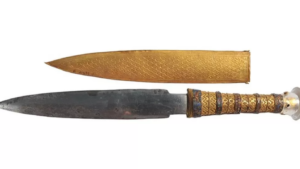Ancient inventions have always been a source of knowledge about the unknown, helping historians understand the world from the past. However, some inventions stood way ahead of their time. In turn, this raised questions about the advancement of the civilization they belonged to.
Moreover, the revolutionary thought process behind these technologies made them even more special. The list goes on, starting from King Tut’s space dagger to the 2000 years old analog computer. But have you ever imagined where the idea of these inventions had come from? Were they some alien invention or the magic of science? Well, let’s help you find out about the unknown.
King Tut’s Space Dagger
The discovery of Tutankhamun’s tomb in 1922 by British Archaeologist Howard Carter opened up many questions and surprises for the world to notice. The finding was full of mysteries and interesting facts, offering much information regarding the world during King Tut’s reign (1333 B.C. to 1323 B.C.).
However, of all the ancient Inventions from King Tut’s tomb, the most fascinating one was his iron space dagger with gold decorations (34-centimeter in length), predating the iron age of Egypt by 2000 years.
Over the years, historians/archaeologists have done their best to discover the dagger’s source. An X-ray (1970) confirmed the space dagger to be made of top-notch nickel and fine crystallized metal that often came from meteors.

To look further into the origin and locality of the dagger, the researchers went on with its chemical analysis. They found high concentrations of manganese nickel, sulfur, and iron with Widmanstätten patterns on the blade. All of these concluded that the dagger was from an octahedrite meteorite, the most common type.
However, more than the chemical analysis, clay tablets proved that the iron dagger was probably a gift to Amenhotep III (Tutankhamun’s grandfather) from the King of Syria – then known as Mitanni.
Later on, another team of researchers did come up with a separate study and published them in the book by American University in Cairo Press, 2022 – “Iron from Tutankhamun’s Tomb.” The team has highlighted that it is not possible to reach a concrete conclusion about Tutankhamun’s iron objects as of now. As the parts of the Iron Dagger hail from different places, archaeologists are still working on finding out the exact origin of the same.
2000+ Years Old Analogue Computer
While searching for sea sponges (1901), divers stumbled upon a deposit of sunken wreckage from classical times in the coastal region of the small Greek island Antikythera (located between Crete and Kythera). Termed the ‘Antikythera mechanism,’ historians believe it was a 2200 years old analog computer made of bronze components kept safe in a wooden box.
Now placed at the National Archaeological Museum in Athens, radiographic imaging helped archaeologists discover that the Antikythera tool’s doors and other parts are covered with Greek inscriptions. Also, the same study did find 30 gear wheels made of bronze sheets inside, which helped ancient Greeks predict the location of celestial objects.

The historians believe that a hand turn shaft connected the crown gear with the primary gear wheel, which drove the other gear wheels. Each resolution of the main gear equals a full solar year.
A 2021’s attempt at replicating the Antikythera tool, among other ancient inventions, did help scientists create a genius – combining different cycles from Plato’s Academy, Babylonian Astronomy, and other celestial theories from Ancient Greece. The instrument completed proper calculations of the Sun & Moon’s ecliptic longitudes, synodic phases of each planet, and the Olympiad cycle.
The Nimrud Lens – World’s First Optical Lens
In 1850, Sir Austen Henry Layard, during his excavation across Northern Iraq’s Assyrian city of Nimrud, came across a lens in an oval shape. He named the object Layard or Nimrud lens. Thus marking the discovery of the world’s first optical lens with a focal length of 12 centimeters. Researchers do date the quartz crystal to the 8th century BC. It gets a thickness between 4.10mm to 6.20mm, with 3.45cm in breadth and 4.20cm in length.

To date, the rightful use of the Nimrud lens among all the ancient inventions is widely debated. Archaeologists believe the Assyrians might have used it as a magnifying tool to concentrate sunrays to start a fire. Also, a few scientists claimed that the Nimrud lens was part of a telescope. Backing up the fact – why the Assyrians knew so much about astronomy. But the lack of clarity in the lens did reject such a theory.
As per findings, there are twelve cavities on the surface of the lens, which opened up during grinding and had a type of liquid trapped in the raw crystals.
However, claims by the British Museum have almost shattered all the theories so far, which state that the Nimrud lens has no practical use apart from being a decorative piece.
So that is all about the most prominent ancient inventions ahead of their time. With all three, historians are still trying to come to an absolute conclusion regarding the uses. However, only time can help solve the mystery these items have in store.



